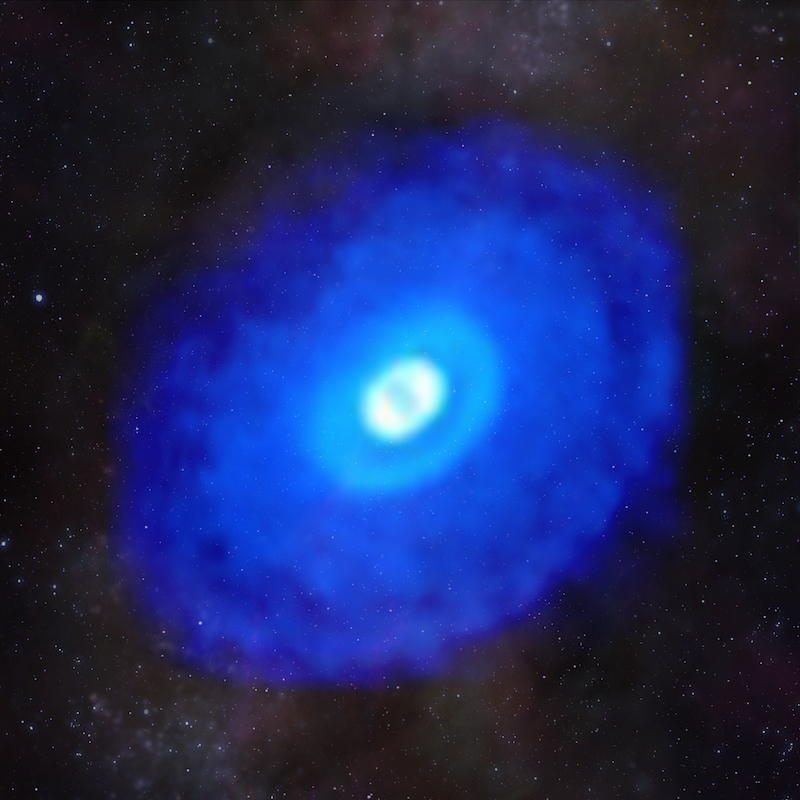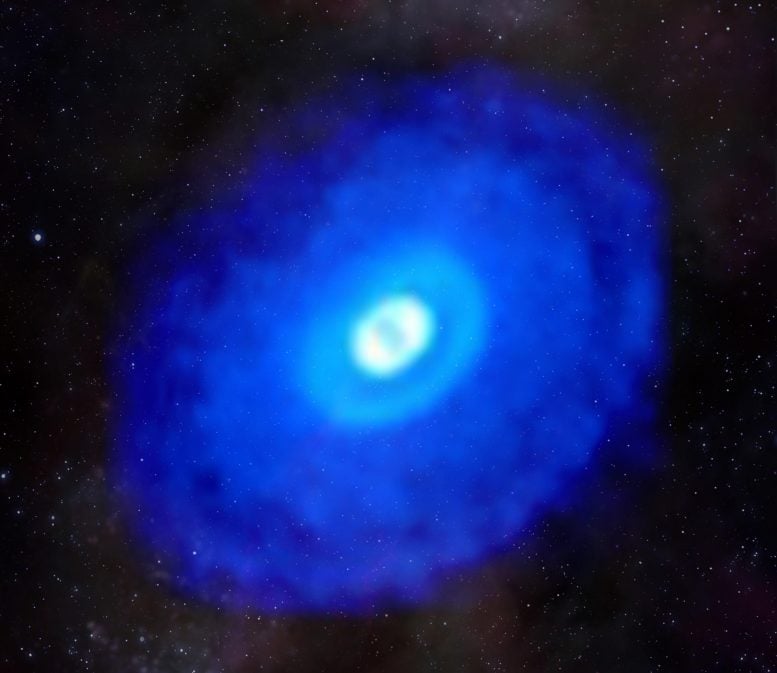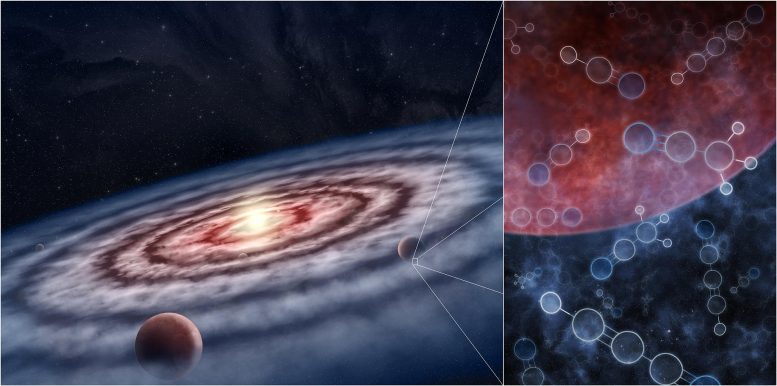Whether that's good news or not is anyone's guess, though.
September 18, 2021
A group of astronomers at the University of Leeds have identified rich reservoirs of life-giving molecules around young stars in our galaxy — which was previously believed to happen only under rare circumstances. The findings suggest that there could be as much as 100 times more of these molecules in the Milky Way than previously thought.
“These planet-forming disks are teeming with organic molecules, some which are implicated in the origins of life here on Earth,” Kartin Öberg, one of the authors, said in a statement. “This is really exciting. The chemicals in each disk will ultimately affect the type of planets that form and determine whether or not the planets can host life.”
The researchers used the Atacama Large Millimetre/submillimetre Array (or ALMA) radio telescope in Chile to look at the composition of the five discs. ALMA can detect even the weakest signals from molecules in outer space thanks to its 60 antennas. Each molecule emits a light at a different wavelength that scientists can investigate.
The researchers looked for certain organic molecules and found them in four of the five disks, and in much larger numbers than they originally anticipated. These molecules are considered essential to life on Earth. They are believed to have reached the planet through asteroids or comets that crashed into Earth billions of years ago.
The theory of the molecules traveling in asteroids and comets was reaffirmed here, as they were located in the same region that produces space rocks. They weren’t evenly distributed in the discs, with each containing a different mix of molecules. For the researchers, this shows that each planet is created based on a different mix of ingredients.
“ALMA has allowed us to look for these molecules in the innermost regions of these disks, on size scales similar to our Solar System, for the first time. Our analysis shows that the molecules are primarily located in these inner regions with abundances between 10 and 100 times higher than models had predicted,” John Ilee, one of the authors, said in a statement.
The researchers specifically looked for three molecules, cyanoacetylene (HC3N), acetonitrile (CH3CN), and cyclopropenylidene (c-C3H2), in five protoplanetary disks, known as IM Lup, GM Aur, AS 209, HD 163296, and MWC 480. The discs were found 300 to 500 lights years from Earth, with each of them showing signals of on-going planet formation.
The next steps
Following this remarkable discovery, the researchers want to keep on searching for more complex molecules in the protoplanetary disks. They are specifically looking forward to the launch of the James Webb Telescope, so far scheduled for December 18th, as it will help to examine the molecules in much greater detail than before, they added.
“If we are finding molecules like these in such large abundances, our current understanding of interstellar chemistry suggests even more complex molecules should also be observable,” Ilee said in a statement. “If we detect them, then we’ll be even closer to understanding how the raw ingredients of life can be assembled around other stars.”
All the studies related to this finding can be accessed here.
Planets Are Born In Cosmic Organic Soups

Planets are born in cosmic soups
Soup lovers know that there are many different kinds of soup, with a wide variety of tasty ingredients to make them unique. On September 15, 2021, astronomers at the Harvard-Smithsonian Center for Astrophysics (CfA) in Cambridge, Massachusetts, released new evidence related to the “cosmic soups” around stars, from which distant exoplanets form. These cosmic soups are the mix of chemicals in protoplanetary disks around the young stars. These disks are the birthplaces of planets. Astronomers have now mapped out the ingredients – the chemicals in five different protoplanetary disks – in extraordinary detail. They’ve found that, just as with the culinary favorites on Earth, no two cosmic soups are alike.
Astronomer Karin Öberg of CfA led the mapping project.
No fewer than 20 new peer-reviewed papers, collectively named “Molecules with ALMA at Planet-forming Scales (MAPS),” have been accepted for publication (pending) in the Astrophysical Journal Supplement. They are also currently available as preprint versions on arXiv (first 20 papers listed).

Implications for life
Specifically, the astronomers examined five different protoplanetary disks and found dozens of different organic molecules. Protoplanetary disks are massive disk-shaped clouds of gas and dust around young stars. In fact, it is in these disks that planets form. These soups of organic molecules are all different from each other and, consequently, can have implications for the possibility of life.
As Öberg said in a statement:
These planet-forming disks are teeming with organic molecules, some of which are implicated in the origins of life here on Earth. This is really exciting; the chemicals in each disk will ultimately affect the type of planets that form and determine whether or not the planets can host life.
Every soup is unique
The organic chemicals are not, however, spread uniformly through the disks. Instead, their locations are more random, meaning that each soup is unique with its own blend of ingredients. This suggests that planets can form in a wide variety of chemical environments. The location of a planet in the disk also makes a big difference, as Öberg explained:
Our maps reveal it matters a great deal where in a disk a planet forms. Many of the chemicals in the disks are organic, and the distribution of these organics varies dramatically within a particular disk. Two planets can form around the same star and have very different organic inventories, and therefore predispositions to life.

Our team used these maps to show where some of the forming planets are located within disks, enabling scientists to connect the observed chemical soups with the future compositions of specific planets.
Location, location, location
In total, the researchers mapped 18 different organic molecules in the protoplanetary disks. This includes hydrogen cyanide and other nitriles connected to the origins of life. The Maps III study that identified the specific locations of the molecules was led by CfA graduate student Charles Law. Law and his colleagues used the Atacama Large Millimeter/submillimeter Array (ALMA) in 2018 and 2019 to study the five protoplanetary disks.
Indeed, they were able to collect so much data that it took two years to analyze the results. A 100-terabyte hard drive was also required to store the data. The data was not only plentiful, it also held surprises, with Law noting that:
Understanding the chemistry occurring even in a single disk is much more complicated than we thought. Each individual disk appears quite different from the next one, with its own distinctive set of chemical substructures. The planets forming in these disks are going to experience very different chemical environments.

Looking for newborn planets
Richard Teague, a Submillimeter Array fellow at CfA, used the data and imagery collected by MAPS to hunt for newborn planets in the protoplanetary disks. They are hard to see directly, due to obscuring gas and dust. He said:
It’s like trying to see a fish underwater. We know they’re there, but we can’t peer that far down. We have to look for subtle signs on the surface of the water, like ripples and waves.
Despite that, the researchers got lucky. Teague analyzed gas velocities in two of the five protoplanetary disks. These disks were around the young stars HD 163296 and MWC 480. Correspondingly, they found small hiccups in velocity in certain portions of the disks, revealing a young Jupiter-like planet embedded in each of the disks.
As the planets grow, they will gradually carve out gaps in the disks, like other gaps that already exist and can be seen by telescopes. The upcoming James Webb Space Telescope should be able to spot the planets themselves, as Teague noted:
It should have the sensitivity to pinpoint the planets.
It will be interesting to see how many newborn planets the Webb finds and what ingredients are present in their individual soups.
Bottom line: Astronomers at the Center for Astrophysics | Harvard & Smithsonian (CfA) have found that planets are born in cosmic soups of organic molecules. These soups have different ingredients, leading to a wide diversity of planets.
Source (preprint): Molecules with ALMA at Planet-forming Scales
Extensive Chemical Composition Mapping Reveals Carbon-Rich, Organic Birth Environments of Planets

This composite image of ALMA data from the young star HD 163296 shows hydrogen cyanide emission laid over an artist’s impression of a starfield. The MAPS project zoomed in on hydrogen cyanide and other organic and inorganic compounds in planet-forming disks to gain a better understanding of the compositions of young planets and how the compositions link to where planets form in a protoplanetary disk. Credit: ALMA (ESO/NAOJ/NRAO)/D. Berry (NRAO), K. Öberg et al (MAPS)
Scientists connect the dots between where planets form and what they’re made of.
An international collaboration of scientists using the Atacama Large Millimeter/submillimeter Array (ALMA) has completed the most extensive chemical composition mapping of the protoplanetary disks around five nearby young stars at high resolution, producing images that capture the molecular composition associated with planetary births, and a roadmap for future studies of the makeup of planet- and comet-forming regions. The new study unlocks clues about the role of molecules in planetary system formation, and whether these young planetary systems in the making have what it takes to host life. The results of the program, appropriately called MAPS, or Molecules with ALMA at Planet-forming Scales, will appear in an upcoming 20-paper special edition of The Astrophysical Journal Supplement Series.
Planets form in the disks of dust and gas—also called protoplanetary disks—surrounding young stars. The chemical makeup of—or molecules contained within—these disks may have an impact on the planets themselves, including how and where planetary formation occurs, the chemical composition of the planets, and whether those planets have the organic composition necessary to support life. MAPS specifically looked at the protoplanetary disks surrounding the young stars IM Lup, GM Aur, AS 209, HD 163296, and MWC 480, where evidence of ongoing planet formation has already been detected. The project led to multiple exciting discoveries, including a link between dust and chemical substructures and the presence of large reservoirs of organic molecules in the inner disk regions of the stars.

In this artist’s conception, planets form from the gas and dust in the protoplanetary disk surrounding the young star. The gas is made up of many different molecules, including hydrogen cyanide and more complex nitriles—linked to the development of life on Earth—and other organic and inorganic compounds. From simple organic compounds to the more complex, the soup of molecules in a particular location in the disk shapes the future of the planet forming there, and determines whether or not that planet could support life as we know it. Credit: M.Weiss/Center for Astrophysics/Harvard & Smithsonian
“With ALMA we were able to see how molecules are distributed where exoplanets are currently assembling,” said Karin Öberg, an astronomer at the Center for Astrophysics | Harvard & Smithsonian (CfA) and the Principal Investigator for MAPS. “One of the really exciting things we saw is that the planet-forming disks around these five young stars are factories of a special class of organic molecules, so-called nitriles, which are implicated in the origins of life here on Earth.”
Simple organic molecules like HCN, C2H, and H2CO were observed throughout the project in unprecedented detail, thanks to the sensitivity and resolving power of ALMA’s Band 3 and Band 6 receivers. “In particular, we were able to observe the amount of small organic molecules in the inner regions of disks, where rocky planets are likely assembling,” said Viviana V. Guzmán, an astronomer at Pontificia Universidad Católica de Chile’s Instituto de Astrofísica, lead author on MAPS VI and a MAPS co-Principal Investigator. “We’re finding that our own Solar System is not particularly unique, and that other planetary systems around other stars have enough of the basic ingredients to form the building blocks of life.”
Scientists also observed more complex organic molecules like HC3N, CH3CN, and c-C3H2—notably those containing carbon, and therefore most likely to act as the feedstock of larger, prebiotic molecules. Although these molecules have been detected in protoplanetary disks before, MAPS is the first systematic study across multiple disks at very high spatial resolution and sensitivity, and the first study to find the molecules at small scales and in such significant quantities. “We found more of the large organic molecules than expected, a factor of 10 to 100 more, located in the inner disks on scales of the Solar System, and their chemistry appears similar to that of Solar System comets,” said John Ilee, an astronomer at the University of Leeds and the lead author of MAPS IX. “The presence of these large organic molecules is significant because they are the stepping-stones between simpler carbon-based molecules such as carbon monoxide, which is found in abundance in space, and the more complex molecules that are required to create and sustain life.”
Molecules are not distributed uniformly across planet-forming disks, however, as evidenced in MAPS III and IV, which revealed that while the general disk compositions appear to be similar to the Solar System, zooming in at high resolution reveals some diversity in composition that could result in planet-to-planet differences. “Molecular gas in protoplanetary disks is often found in sets of distinct rings and gaps,” said Charles Law, CfA astronomer and lead author on MAPS III and IV. “But the same disk observed in different molecular emission lines often looks completely different, with each disk having multiple molecular faces. This also means that planets in different disks or even in the same disk at different locations may form in radically different chemical environments.” This means that some planets form with the necessary tools for building and sustaining life while other nearby planets may not.
One of those radically different environments occurs in the space surrounding Jupiter-like planets, where scientists found the gas to be poor in carbon, oxygen, and heavier elements, while rich in hydrocarbons, such as methane. “The chemistry that is seen in protoplanetary disks should be inherited by forming planets,” said Arthur Bosman, an astronomer at the University of Michigan and lead author of MAPS VII. “Our findings suggest that many gas giants may form with extremely oxygen-poor (carbon-rich) atmospheres, challenging current expectations of planet compositions.”
Taken all together, MAPS is providing exactly that: a map for scientists to follow, connecting the dots between the gas and dust in a protoplanetary disk and the planets that eventually form from them to create a planetary system. “A planet’s composition is a record of the location in the disk in which it was formed,” said Bosman. “Connecting planet and disk composition enables us to peer into the history of a planet and helps us to understand the forces that formed it.”
Joe Pesce, astronomer and ALMA program officer at the National Science Foundation (NSF) notes, “Whether life exists beyond Earth is one of humanity’s fundamental questions. We now know planets are found everywhere, and the next step is to determine if they have the conditions necessary for life as we know it (and how common that situation might be). The MAPS program will help us better answer these questions. ALMA’s search for precursors to life far from Earth complements studies conducted in laboratories, and in places like hydrothermal vents on Earth.”
Öberg added, “MAPS is the culmination of decades of work on the chemistry of planet-forming disks by scientists using ALMA and its precursors. Although MAPS has surveyed just five disks at this time, we had no idea how chemically complex and visually stunning these disks really were until now. MAPS has first answered questions we could not have imagined asking decades ago, and also presented us with many more questions to answer.”
Learn more about the MAPS Program at the project web site.
Highlighted papers
“Molecules with ALMA at Planet-forming Scales (MAPS) I: Program overview and highlights,” K. Öberg et al, The Astrophysical Journal Supplement Series, preview [https://arxiv.org/pdf/2109.06268.pdf]
“Molecules with ALMA at Planet-forming Scales (MAPS) III: Characteristics of radial chemical substructures,” C. Law et al, The Astrophysical Journal Supplement Series, preview [https://arxiv.org/pdf/2109.06210.pdf]
“Molecules with ALMA at Planet-forming Scales (MAPS). IV: Emission Surfaces and Vertical Distribution of Molecules,” C. Law, The Astrophysical Journal Supplement Series, preview [https://arxiv.org/pdf/2109.06217.pdf]
“Molecules with ALMA at Planet-forming Scales (MAPS) VI: Distribution of the small organics HCN, C2H, and H2CO,” V. Guzmán et al, The Astrophysical Journal Supplement Series, preview [https://arxiv.org/pdf/2109.06391.pdf]
“Molecules with ALMA at Planet-forming Scales (MAPS) VII: Substellar O/H and C/H and superstellar C/O in planet-feeding gas,” A. Bosman et al, The Astrophysical Journal Supplement Series, preview [https://arxiv.org/pdf/2109.06221.pdf]
“Molecules with ALMA at Planet-forming Scales (MAPS) IX: “Distribution and properties of the large organic molecules HC3N, CH3CN, and c-C3H2,” J. Ilee et al, The Astrophysical Journal Supplement Series, preview [https://arxiv.org/pdf/2109.06319.pdf]
About ALMA
The Atacama Large Millimeter/submillimeter Array (ALMA), an international astronomy facility, is a partnership of the European Organisation for Astronomical Research in the Southern Hemisphere (ESO), the U.S. National Science Foundation (NSF), and the National Institutes of Natural Sciences (NINS) of Japan in cooperation with the Republic of Chile. ALMA is funded by ESO on behalf of its Member States, by NSF in cooperation with the National Research Council of Canada (NRC) and the Ministry of Science and Technology (MOST) and by NINS in cooperation with the Academia Sinica (AS) in Taiwan and the Korea Astronomy and Space Science Institute (KASI).
ALMA construction and operations are led by ESO on behalf of its Member States; by the National Radio Astronomy Observatory (NRAO), managed by Associated Universities, Inc. (AUI), on behalf of North America; and by the National Astronomical Observatory of Japan (NAOJ) on behalf of East Asia. The Joint ALMA Observatory (JAO) provides the unified leadership and management of the construction, commissioning and operation of ALMA.
No comments:
Post a Comment